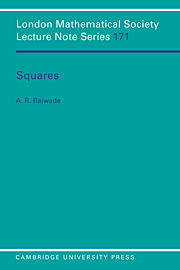Book contents
- Frontmatter
- Contents
- Preface
- Notation
- Chapter 1 The theorem of Hurwitz (1898) on the 2, 4, 8-identities
- Chapter 2 The 2n-identities and the Stufe of fields: theorems of Pfister and Cassels
- Chapter 3 Examples of the Stufe of fields and related topics
- Chapter 4 Hilberts 17th problem and the function fields ℝ(X), ℚ(X) and ℝ(X, Y)
- Chapter 5 Positive semi-definite functions and sums of squares in ℝ(X1X2, … Xn)
- Chapter 6 Introduction to Hilbert's theorem (1888) in the ring ℝ[X1, X2, … Xn]
- Chapter 7 The two proofs of Hilbert's main theorem; Hilbert's own and the other of Choi and Lam.
- Chapter 8 Theorems of Reznick and of Choi, Lam and Reznick
- Chapter 9 Theorems of Choi, Calderon and of Robinson
- Chapter 10 The Radon function and the theorem of Hurwitz-Radon (1922–23)
- Chapter 11 Introduction to the theory of quadratic forms
- Chapter 12 Theory of multiplicative forms and of Pfister forms
- Chapter 13 The rational admissibility of the triple (r, s, n) and the Hopf condition
- Chapter 14 Some interesting examples of bilinear identities and a theorem of Gabel
- Chapter 15 Artin-Schreier theory of formally real fields
- Chapter 16 Squares and sums of squares in fields and their extension fields
- Chapter 17 Pourchet's theorem that P(Q(x)) = 5 and related results
- Chapter 18 Examples of the Stufe and pythagoras number of fields using the Hasse-Minkowski theorem
- Appendix 1 Reduction of matrices to canonical forms (for Chapter 10)
- Appendix 2 Convex sets (for chapters 6, 7, 8, 9)
- References
- Index
Chapter 3 - Examples of the Stufe of fields and related topics
Published online by Cambridge University Press: 27 October 2009
- Frontmatter
- Contents
- Preface
- Notation
- Chapter 1 The theorem of Hurwitz (1898) on the 2, 4, 8-identities
- Chapter 2 The 2n-identities and the Stufe of fields: theorems of Pfister and Cassels
- Chapter 3 Examples of the Stufe of fields and related topics
- Chapter 4 Hilberts 17th problem and the function fields ℝ(X), ℚ(X) and ℝ(X, Y)
- Chapter 5 Positive semi-definite functions and sums of squares in ℝ(X1X2, … Xn)
- Chapter 6 Introduction to Hilbert's theorem (1888) in the ring ℝ[X1, X2, … Xn]
- Chapter 7 The two proofs of Hilbert's main theorem; Hilbert's own and the other of Choi and Lam.
- Chapter 8 Theorems of Reznick and of Choi, Lam and Reznick
- Chapter 9 Theorems of Choi, Calderon and of Robinson
- Chapter 10 The Radon function and the theorem of Hurwitz-Radon (1922–23)
- Chapter 11 Introduction to the theory of quadratic forms
- Chapter 12 Theory of multiplicative forms and of Pfister forms
- Chapter 13 The rational admissibility of the triple (r, s, n) and the Hopf condition
- Chapter 14 Some interesting examples of bilinear identities and a theorem of Gabel
- Chapter 15 Artin-Schreier theory of formally real fields
- Chapter 16 Squares and sums of squares in fields and their extension fields
- Chapter 17 Pourchet's theorem that P(Q(x)) = 5 and related results
- Chapter 18 Examples of the Stufe and pythagoras number of fields using the Hasse-Minkowski theorem
- Appendix 1 Reduction of matrices to canonical forms (for Chapter 10)
- Appendix 2 Convex sets (for chapters 6, 7, 8, 9)
- References
- Index
Summary
Before we take up specific examples, we would like to say something about how representations of an integer as a sum of squares (SOS) in Q is related to that in Z, and indeed more generally about how the representation of an element a of an integral domain A as an SOS in A is related to the representation of a as an SOS in the field of quotients F of A. We paraphrase our questions more explicitly as follows:
Question 1. If a ∈ A is an SOS of n elements of F then is a an SOS of elements of A?
Question 2. If the answer to Question 1 is ‘yes’ then is a an SOS of the same number n of elements of A?
The lemma of Cassels proved in the last chapter is an excellent example of a problem of this nature, where the answer to both the above questions is given in the affirmative (A being the ring K[t], K a field). Note that the answer to the first question was proved to be in the affirmative by Artin already in 1927; but the second was not answered then.
Another very instructive example is provided in the case A = Z, so that F = Q; the answers to both the questions being in the affirmative and this result is often called the Davenport-Cassels lemma.
- Type
- Chapter
- Information
- Squares , pp. 29 - 45Publisher: Cambridge University PressPrint publication year: 1993
- 1
- Cited by

